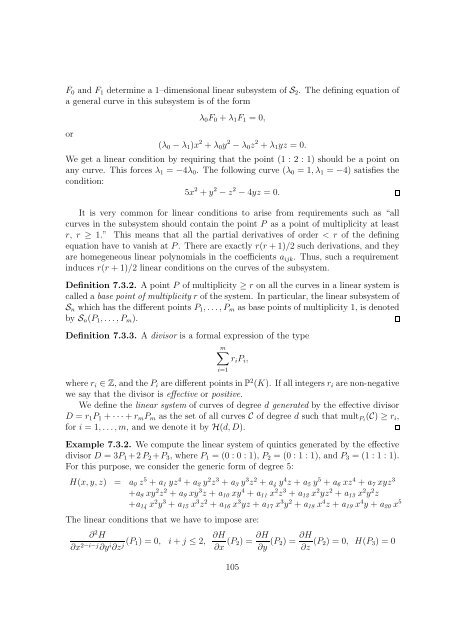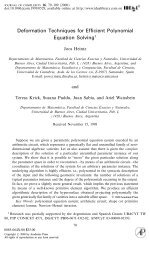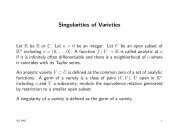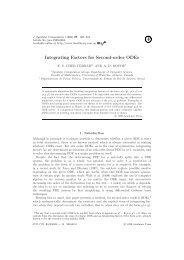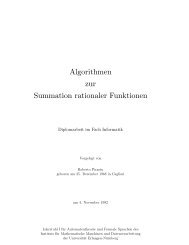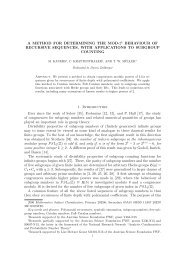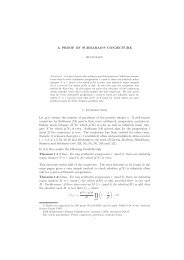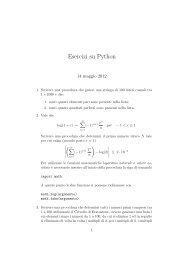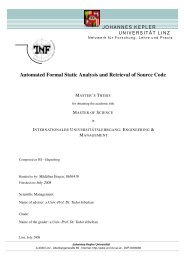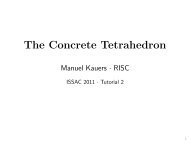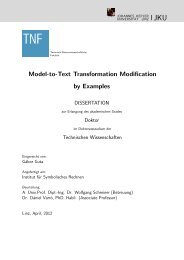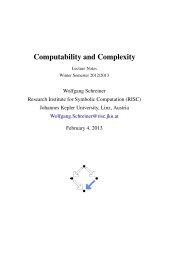Chapter 7 Local properties of plane algebraic curves - RISC
Chapter 7 Local properties of plane algebraic curves - RISC
Chapter 7 Local properties of plane algebraic curves - RISC
Create successful ePaper yourself
Turn your PDF publications into a flip-book with our unique Google optimized e-Paper software.
F 0 and F 1 determine a 1–dimensional linear subsystem <strong>of</strong> S 2 . The defining equation <strong>of</strong><br />
a general curve in this subsystem is <strong>of</strong> the form<br />
or<br />
λ 0 F 0 + λ 1 F 1 = 0,<br />
(λ 0 − λ 1 )x 2 + λ 0 y 2 − λ 0 z 2 + λ 1 yz = 0.<br />
We get a linear condition by requiring that the point (1 : 2 : 1) should be a point on<br />
any curve. This forces λ 1 = −4λ 0 . The following curve (λ 0 = 1, λ 1 = −4) satisfies the<br />
condition:<br />
5x 2 + y 2 − z 2 − 4yz = 0.<br />
It is very common for linear conditions to arise from requirements such as “all<br />
<strong>curves</strong> in the subsystem should contain the point P as a point <strong>of</strong> multiplicity at least<br />
r, r ≥ 1.” This means that all the partial derivatives <strong>of</strong> order < r <strong>of</strong> the defining<br />
equation have to vanish at P. There are exactly r(r + 1)/2 such derivations, and they<br />
are homegeneous linear polynomials in the coefficients a ijk . Thus, such a requirement<br />
induces r(r + 1)/2 linear conditions on the <strong>curves</strong> <strong>of</strong> the subsystem.<br />
Definition 7.3.2. A point P <strong>of</strong> multiplicity ≥ r on all the <strong>curves</strong> in a linear system is<br />
called a base point <strong>of</strong> multiplicity r <strong>of</strong> the system. In particular, the linear subsystem <strong>of</strong><br />
S n which has the different points P 1 , . . .,P m as base points <strong>of</strong> multiplicity 1, is denoted<br />
by S n (P 1 , . . .,P m ).<br />
Definition 7.3.3. A divisor is a formal expression <strong>of</strong> the type<br />
m∑<br />
r i P i ,<br />
i=1<br />
where r i ∈ Z, and the P i are different points in P 2 (K). If all integers r i are non-negative<br />
we say that the divisor is effective or positive.<br />
We define the linear system <strong>of</strong> <strong>curves</strong> <strong>of</strong> degree d generated by the effective divisor<br />
D = r 1 P 1 + · · · + r m P m as the set <strong>of</strong> all <strong>curves</strong> C <strong>of</strong> degree d such that mult Pi (C) ≥ r i ,<br />
for i = 1, . . ., m, and we denote it by H(d, D).<br />
Example 7.3.2. We compute the linear system <strong>of</strong> quintics generated by the effective<br />
divisor D = 3P 1 +2 P 2 +P 3 , where P 1 = (0 : 0 : 1), P 2 = (0 : 1 : 1), and P 3 = (1 : 1 : 1).<br />
For this purpose, we consider the generic form <strong>of</strong> degree 5:<br />
H(x, y, z) = a 0 z 5 + a 1 yz 4 + a 2 y 2 z 3 + a 3 y 3 z 2 + a 4 y 4 z + a 5 y 5 + a 6 xz 4 + a 7 xyz 3<br />
+a 8 xy 2 z 2 + a 9 xy 3 z + a 10 xy 4 + a 11 x 2 z 3 + a 12 x 2 yz 2 + a 13 x 2 y 2 z<br />
+a 14 x 2 y 3 + a 15 x 3 z 2 + a 16 x 3 yz + a 17 x 3 y 2 + a 18 x 4 z + a 19 x 4 y + a 20 x 5<br />
The linear conditions that we have to impose are:<br />
∂ 2 H<br />
∂x 2−i−j ∂y i ∂z j (P 1) = 0, i + j ≤ 2,<br />
∂H<br />
∂x (P 2) = ∂H<br />
∂y (P 2) = ∂H<br />
∂z (P 2) = 0, H(P 3 ) = 0<br />
105


